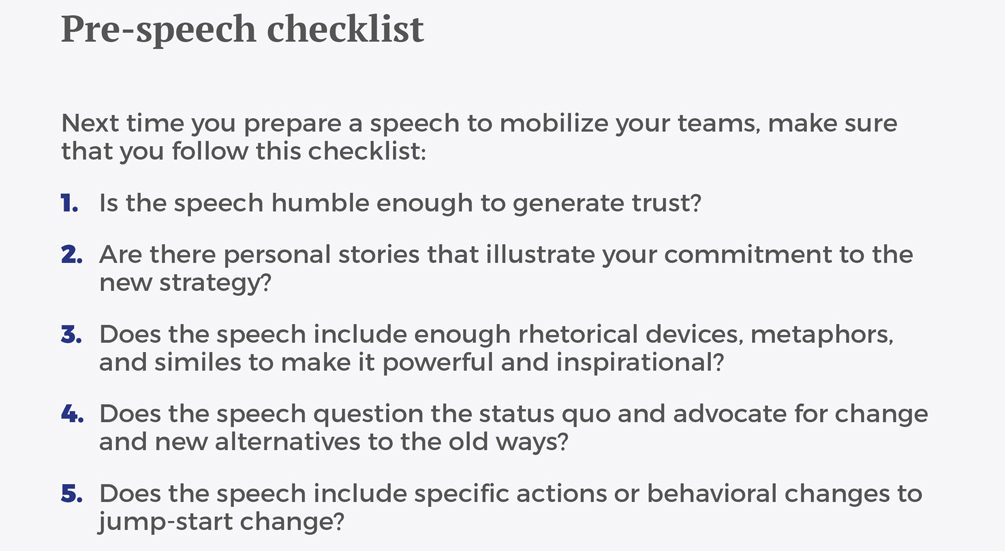But what distinguishes these powerful speeches from other more ordinary communicative discourse? They mobilize people to action. These speeches come across as authentic, passionate, inspirational, innovative, and most importantly, they provide important cues for action.
Leadership scholars have long noticed that leaders tend to approach their role with two different styles that permeate their communication and their relationships with their followers. Some leaders approach their role from a transactional perspective. They see their leadership role as a mere exchange process in which they administer rewards to motivate their teams to achieve their goals. They are content with their managerial role as wardens and custodians of the status quo.
Other leaders, however, approach their role from a more innovative and inspirational perspective. Moved by change, they inspire their teams to develop themselves further and to achieve difficult and extraordinary goals.
We follow leaders who are real people, who stand for something, and who share their most essential values with us.
Five critical communication strategies
The latest research shows that inspirational leaders outperform transactional leaders by 30%. Inspirational leaders exercise a powerful influence over their teams by using five critical communication strategies:
- Generate trust through authentic communication. Building trust is essential to gain the legitimacy that leaders need to mobilize their followers. Expressing a moral conviction about their goals, convincingly telling the truth, admitting mistakes, and acknowledging shortcomings serve to establish credibility and get followers to identify with the leader and his or her mission. In addition, these messages need to be accompanied by the right facial expressions. A study by Jonathan Freeman found that a neutral face with a slightly upturned mouth and eyebrows makes people look more trustworthy. Moreover, Alexander Todorov and his colleagues from Princeton University found that people make judgments about trustworthiness after being exposed to a facial expression for less than 100 milliseconds. Authenticity is an inside-out process, but before an important speech it is important to practice your facial expressions in the mirror.
- Share personal stories that show your passion for your goals. People follow leaders who they can identify with. Many executives keep their private lives from their followers in order to convey an ideal portrayal of a powerful leader. Nothing could be further from the truth. We follow leaders who are real people, who stand for something, and who share their most essential values with us. Through our personal stories, people learn what we are passionate about and we become role models for people to follow. People are attracted to stories. We are social beings, and as such, we are wired to pay attention to interpersonal stories that tell us about survival, hope, success, and greatness. Peter Drucker, considered by many to be the founding father of modern management, dedicated his career to promoting self-management skills among executives because he firmly believed that self-management and role-modeling were the most powerful leadership skills for influencing followers. To paraphrase Ralph Waldo Emerson, your actions speak so loudly that people cannot hear your voice. To become a role model, share many personal stories and anecdotes to exemplify what you want your followers to do.
- Use rhetorical devices to make the speech memorable. Communication that mobilizes people is memorable and engaging. Leadership researcher John Antonakis identified twelve key rhetorical devices that make leaders appear charismatic and inspirational. After training executives in these language devices, their leadership ratings increased by a full 60%. Using metaphors, repetition, similes, and analogies, asking rhetorical questions, making statements that reflect the sentiments of the people, and setting hard goals are among the most powerful inspirational devices. Martin Luther King, Jr.’s “I Have a Dream” speech is so memorable because it is a literary masterpiece filled with rhetorical devices. King skillfully matched his choice of words and literary devices with the strength of his message to produce an unforgettable speech.
Communication that mobilizes people is memorable and engaging.
- Help people to think outside the box. Trust and inspiration are necessary to motivate and excite people about their goals, but they are not sufficient to move people to action. It would not make sense for a leader to be an excellent communicator but not back it up with action. Effective leaders help followers to define problems in a new way and propose alternative paths to action. Steve Jobs, one of the most charismatic orators of recent times, exemplified this quality in his speeches. He did not design any devices or do any software coding. He was the orchestra conductor who helped his team to think differently. In a famous 1997 speech at Macworld Boston, when Apple seemed to be completely defeated by Microsoft, he advocated a radical change in Apple’s strategy by reframing the way they thought. He asked his employees not to focus on beating Microsoft but on making Apple great. This reframing in the way of thinking marked Apple’s turnaround in the following years.
- Include easy-to-follow cues to action. Effective communication includes specific cues to move people to action. In 1965, the social psychologist Howard Leventhal decided to explore the most effective way to convince students at Yale University to get the tetanus vaccine. He prepared two versions of a booklet explaining the dangers of tetanus and the benefits of vaccination. One version described tetanus with very graphic details and pictures, while the other toned down the dangers, providing only basic information. The results were disappointing: very few students went to the health care center to be vaccinated. When Malcolm Gladwell redid the experiment, he included a campus map with the health care center circled in red, and the vaccination rate rose to 28%. Interestingly enough, the students came equally from both groups. Information alone was not enough to move people to action. They needed a cue: the map. Effective leaders make sure that their speeches include easy-to-follow cues to jump-start their teams.

© IE Insights.











